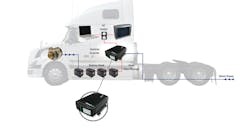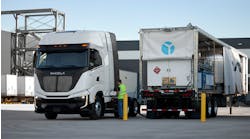Truck drivers love power inverters. With them they can plug in their electronic devices like they can at home. Fleets, however, can be nervous about inverters and their potential to damage the truck’s electrical system.
Steve Carlson, OEM sales manager at Xantrex, a world leader in the development, manufacturing and marketing of advanced power electronic products, offers some advice on spec’ing inverters.
WHAT SIZE INVERTER?
Inverter sizes range from 300-watt cigarette lighter plug-in inverters to 5,000-watt units. Carlson recommends that fleets consider truck size and power usage, and understand how an inverter will be used – what items drivers want powered and what items will be used at the same time. This will help “right size” the inverter for their operations.
As an example, a driver will often run a microwave, TV and laptop all at the same time. A microwave might be rated at 1,000 watts, a TV at 250 watts and a laptop at 95 watts.
Add them up to see how much continuous power you’ll need and then add 20 percent, he says. In this case, the truck will need just over 1,600 watts. “Round up to find an inverter that meets the power needs.”
WHAT ABOUT SURGE POWER?
Power surge is important because “whenever you power up any device, the initial load is more – and sometimes double – what the continuous power requirement is,” explains Carlson. “Therefore, the surge rating on quality inverters should be about double.”
Also important is how long the inverter can handle the surge – the longer the better, he adds. Some inverters can handle only a few milliseconds of surge before the power draw shuts down the inverter. Others can last five seconds or more, and that’s what buyers should look for.
SINE OR MODIFIED SINE WAVE?
Both types well in a truck environment, Carlson says, but for those running sensitive electronics (like CPAP machines) or products that are plugged into their own chargers – a drill or a toothbrush – a sine wave should be the preferred choice.
Sine wave power is the same power as what you get at home – meaning the voltage is consistent without spikes or drops. However, if you’re powering run of the mill electronics and appliances, modified sine wave power is just fine, he notes.
RELIABILITY
An inverter that has a “Regulatory Listed” approval – such as UL or ETL with UL458 rating – means the inverter was inspected and approved by an independent agency which safeguards against issues with electricity.
The Technology & Maintenance Council (tmc.trucking.org) has two recommended practices - RP 163 and RP 160 – that advocate the use of UL458 listed inverters installed in a truck, notes Carlson.
Inverters installed by truck manufacturers all are UL approved, he says, but many inverters sold at truckstops are not.
BATTERY CHARGER
Carlson recommends the use of an inverter with a battery charger if shorepower can be used.
“When plugged in, you can run everything you’re running with your inverter for as long as you want, plus you can recharge and top off your batteries. The more you can use shorepower, the better, as it prolongs the life of your batteries.”




